Positive Health Online
Your Country

Applied Phytomedicine Treatment for Herpes Zoster (Shingles)
listed in herbal medicine, originally published in issue 178 - January 2011
Herpes zoster is an acute neurodermic viral infection of the dorsal root ganglia of the spinal cord or the extramedullary cranial nerve ganglia. It is caused by reactivation of (Varicella Zoster Virus - (VZV) which lies dormant in the sensory ganglia after an earlier episode of chickenpox and involves the dermatome supplied by the sensory nerve that arises from the ganglion. (Herpes Zoster infection - HZI) is predominantly a disease of the middle-aged and elderly. From 5 to 10 cases per 1,000 persons are seen between the sixth and eighth decades of life. Fewer than 5% of attacks occur in persons under 10 years of age.[1]
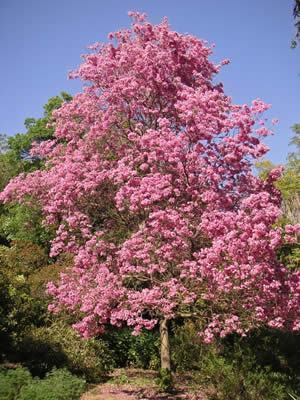
Tabebuia impetiginosa
Herpes is a Greek term meaning something that creeps. In the Hippocratic era, medical practitioners used the term to denote a rash. Zoster is another Greek term used to denote a belt or a girdle. Acute herpes zoster and chronic postherpetic neuralgia (PHN) are two ends of a spectrum of diseases that comprises a subset of patients commonly encountered in pain clinics. Although this disease has been epidemiologically and clinically well discussed for more that 30 years, it remains one of the most elusive diseases to treat for pain clinicians, most notably in the chronic state referred to as PHN.[2]
Epidemiology
Approximately 8% of patients admitted to the hospital with HZI have an underlying disease, such as chronic hepatitis C (HCV), human immunodeficiency virus (HIV), diabetes mellitus, leukaemia, Hodgkin disease, or other malignancy. Attacks also may be precipitated by surgical stress, immunosuppressive therapy, physical trauma and radiation therapy.[3]
This shows that herpes zoster is a disease of the elderly and the immune-compromised individuals, and some reports indicate that roughly one third of the people who have had varicella will develop an episode of herpes zoster. Interestingly, the rate of the second attack is as high as the first attack. This would indicate that we do not form serological defence to repeat infections after an initial bout with herpes zoster.[4]
In order to adequately treat and potentially prevent PHN, it is imperative to fully understand the nature of the course of acute herpes zoster.
Pathogenesis
The pathogenesis of herpes zoster begins with infection of the (VZV) commonly referred to as chickenpox in childhood. The virus establishes a latent infection in satellite cells of dorsal sensory ganglia and is eventually reactivated during times of decreased cellular immunity, as in the elderly or immuno-compromised patient. Reactivation then leads to infection of other cells within the ganglia, and as infectious virus spreads to the peripheral nerve, it travels in a centrifugal fashion to cause inflammation of the peripheral nerve, eventually reaching the skin to cause the characteristic eruptions. This inflammation also travels proximally to reach the leptomeninges and dorsal horn of the spinal cord or the trigeminal brain complex in some patients.[5]
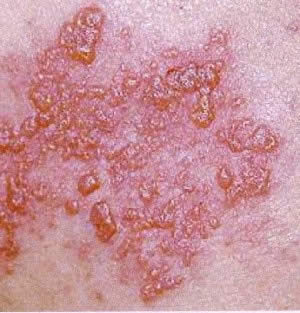
Herpes zoster shingles
Therefore, during acute zoster inflammation, destruction of the neural tissue extends from the dorsal root to the skin. Pathological changes characterized by neuronal loss and destruction, with abundant mononuclear inflammatory infiltrates, can be seen by light microscopy in the affected ganglion, nerve root, and peripheral nerve within weeks of reactivation.[6]
Characteristically, the condition presents as a painful unilateral vesicular rash, usually restricted to the distribution of a sensory nerve. The thoracolumbar trunk (especially T3 to L3) is most commonly affected. HZI may affect cranial nerves, and the trigeminal nerve is then the most frequently affected (18.5%-22% of total cases). Trigeminal nerve involvement is usually unilateral and limited to a single division, more often the first (ophthalmic).[7] Oral manifestations appear when the second or third division is affected. A rare form without vesicular eruption also has been documented. Perhaps the most significant complication of HZI is postherpetic neuralgia. Other complications include motor nerve palsy, optic neuropathy, blindness, encephalitis, and cutaneous calcinosis.[8]
Case Report
A 48-year-old man visited our clinic, complaining of a sharp, piercing and burning pain on the left thoracic dermatome. The patient had no history of other spinal diseases, neuromuscular diseases, abdominal operations, or infections. One week before his referral, he had noticed a rash with blisters on his right flank spreading to the front, which was accompanied by slight pain. Upon physical examination grouped vesicles on an erythematous base were clearly visible on the site of the pain at the T12 to L1 levels.
The patient reported also malaise, fever, and lethargy. The patient's temperature measured 38.5 degrees Celsius. Laboratory investigations showed marked lymphopenia, (1.02 x10^9/L [normal range 1.2 - 3.65 x10^9/ L]) with reactive lymphocytes present, suggestive of a viral infection. A Tzanck smear derived from the base of the lesions demonstrated multinucleated giant cells. Serology showed an elevated IgG antibody titre to VZV. Other investigations were within normal limits (routine haematological test, fasting blood sugar, and routine urine analysis). A diagnosis of Herpes Zoster, commonly known as shingles, was made.
Internal treatment consisted of immune enhancing phytomedical herbs to assist the fight against the virus and key medicinal herbs included Echinacea purpurea radix, Tabebuia impetiginosa, Andrographis paniculata and Hypericum perforatum. These herbs were formulated into a tincture as 1:2 liquid extracts. The prescribed dosage required the patient to take 5ml of the tincture three times a day after food for the duration of one month.
Topical treatment of lesions included the following plant extracts: Calendula officinalis, Melissa officinalis and Glycorrhiza glabra radix. The latter extracts were formulated to an ointment and applied four times a day neat to the lesions and covered with an occlusive dressing for the duration of one month.
At a follow-up visit 1 month after treatment, the skin vesicles had healed, and there were no residual sequelae of herpes zoster.
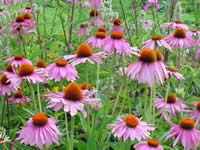
Echinacea purpurea
Discussion
Echinacea, also known as purple coneflower, can be subdivided into three major species, E. purpurea, E. angustifolia, and E. Pallida. These species have been studied for their possible pharmacological and immunological effects and E. purpurea was reported to increase chemotoxicity in neutrophils and production of TNFa, interleukin (IL)-10, IL-6, and IL-1ß in macrophages.[9]
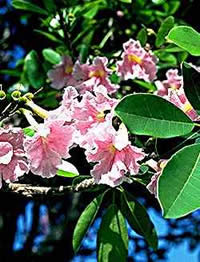
Tabebuia impetiginosa
Red Lapacho (Tabebuia impetiginosa, syn. Tabebuia avellanedae), a canopy tree indigenous to the Amazonian rainforest and other parts of South America, has been acclaimed to be one of the 'miraculous' cures for cancer and tumours. For the first time, during the 1960s, it attracted considerable attention in Brazil and Argentina as a 'wonder drug'. Traditionally, the botanical drug is widely used in local and traditional phytomedicine, usually ingested as a decoction prepared from the inner bark of the tree to treat numerous conditions like bacterial and viral infections, fever, syphilis, malaria, trypanosomiasis, as well as stomach and bladder disorders. As early as 1873, biomedical uses of Red Lapacho (Pau D'Arco) were reported. Natural sciences interest in the plant also began in the 1960s when the United States National Cancer Institute (NCI) systematically began researching plant extracts all over the world looking for active compounds against cancer and looked at Tabebuia impetiginosa in considerable detail. Two main bioactive components have been isolated from Tabebuia impetiginosa: lapachol and ß-lapachone. ß-Lapachone is considered to be the main anti-tumour compound, and pro-apoptotic effects were observed in vitro.[10]
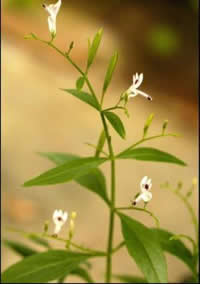
Andrographis paniculata
Andrographis paniculata, also known as the King of bitters, presents a strong candidature as a therapeutic anti-inflammatory agent. It is known to have wide application against multitude of clinical conditions. Number of active principles has been reported from the plant, which mainly includes diterpene lactones, flavonoids, polyphenols and stigmasterols. The aerial part of the plant is used to extract its core components, the bicyclic diterpene lactones viz. andrographolide, isoandrographolide, neoandrographolide and 14-deoxy-11,12-didehydroandrographolide and; among these, andrographolide is the prime component which is biologically most active and constitutes about 70% of the plant extract fraction.[11]
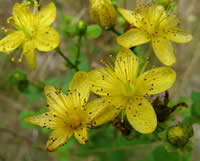
Hypericum perforatum
St. John's wort (Hypericum perforatum) is a popular herbal supplement with serotonergic properties similar to 5-HT receptor agonists and antidepressants such as selective serotonin reuptake inhibitors (SSRI). In addition to ameliorating depression, serotonergic pharmacotherapy has been associated with enhanced innate immune function. Specifically, antidepressant treatment augments natural killer (NK) cell activity (NKCA) which is regarded as a salient component of the innate immune system. NK cells are large granular lymphocytes which comprise a first line of defence against viral infected and cancerous cells. Serotonergic agents may thus directly modulate immune function through 5-HT receptors and 5-HT transporters located on immunocytes.[12]
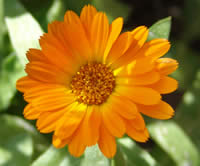
Calendula officinalis
Calendula officinalis preparations stimulate granulation and increase collagen metabolism at the wound site. Fibroblasts, which are involved in granulation and collagen metabolism, are stimulated by Calendula extracts resulting in proliferation and migration within the wound site.[13]
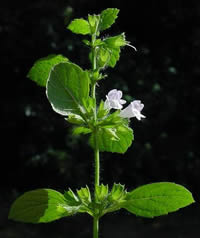
Melissa officinalis
Extracts and essential oils of medicinal plants are increasingly of interest as novel drugs of antimicrobial and antiviral agents. Main constituents of Melissa officinalis essential oil were identified as monoterpenaldehydes citral a, citral b and citronellal. Considering the lipophilic nature of lemon balm essential oil, which enables it to penetrate the skin, and a high selectivity index, Melissa officinalis oil might be suitable for topical treatment of herpetic infections.[14]
Licorice extracts and its principle component, glycyrrhizin, have extensive use in foods, tobacco and in both traditional and herbal medicine. Biochemical studies indicate that glycyrrhizinates inhibit 11ß-hydroxysteroid dehydrogenase, the enzyme responsible for inactivating cortisol. As a result, the continuous, high level exposure to glycyrrhizin compounds can produce hypermineralocorticoid-like effects in both animals and humans. These effects are reversible upon withdrawal of licorice or glycyrrhizin. Other in vivo and clinical studies have reported beneficial effects of both licorice and glycyrrhizin consumption including anti-ulcer, anti-viral, and hepatoprotective responses.[15]
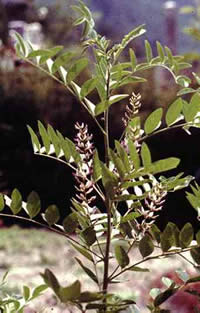
Glycorrhiza glabra
Herpes zoster results from the reactivation of VZV latent in the dorsal root and cranial nerve ganglia following varicella. Reactivation of VZV is thought to be due to a waning VZV-specific T cell responses; thus the elderly and immunocompromised patients are at greatest risk for developing herpes zoster.[16] Herpes zoster in an immunocompetent host may often resolve in less than two months of treatment with the internal and external phytomedical treatment described by the author in this case report. These phytomedical prescriptions, are mostly effective in the treatment of non-disseminated herpes zoster.
References
1. Insinga, Itzler, Pellissier, Saddier and Nikas, The incidence of herpes zoster in a United States administrative database, J Gen Intern Med 20: 748-753. 2005.
2. Fougère, Baudemont, Bellarbre, Paccalin, Herpes Zoster in two non contiguous dermatomes: Case report European Geriatric Medicine, Volume 1, Issue 5: 306-307. October 2010.
3. Mitka, FDA approves shingles vaccines: herpes zoster vaccine targets older adults, JAMA 296 (2): 157-158. 2006.
4. Arvin, Varicella-zoster virus, Microbiol Rev 9 (3): 361-381. 1996.
Brown and Dattner, Phytotherapeutic approaches to common dermatologic conditions, Archives of Dermatology 134: 1401-1404. 1998.
5. Ormrod and Goa, Valaciclovir: a review of its use in the management of herpes zoster, Drugs 59 (6): 1317-1340. 2000.
6. Brown, McCrary and Tyring, Varicella-zoster virus (herpes 3), J Am Acad Dermatol 47 (6): 972-997. 2002.
7. O'Toole, Mooney and Walsh et al., Disseminated herpes zoster in the elderly, Ir J Med Sci 166 (3): 141-142. 1997.
8. Gupta, Jain, Gardiner and Tyring, A rare case of disseminated cutaneous zoster in an immunocompetent patient, BMC Fam Pract 6: 50. 2005.
9. Burger, Echinacea-induced cytokine production by human macrophages, Int. J. Immunopharmacol. 19: 371-379. 1997.
10. Cragg and Newman, 2005, Plants as a source of anticancer agents, Journal of Ethnopharmacology 100:. 72-79. 2005.
11. Coon and Ernst, Andrographis paniculata in the treatment of upper respiratory tract infections: a systemic review of safety and efficacy, Planta Med 70: 293-298. 2004.
12. Öztürk, Korkmaz and Öztürk, Wound-healing activity of St. John's Wort (Hypericum perforatum L.) on chicken embryonic fibroblasts Original Research Article Journal of Ethnopharmacology, Volume 111, Issue 1: 33-39. 20 April 2007.
13. Gurtner, G. et al. Wound repair and regeneration. Nature 453, 314-321. 2008.
14. Schnitzler, Schuhmacher, Astani, J Reichling, Melissa officinalis oil affects infectivity of enveloped herpesviruses Original Research Article, Phytomedicine, Volume 15, Issue 9: 734-740. 3 September 2008.
15. Isbrucker and Burdock, Risk and safety assessment on the consumption of Licorice root (Glycyrrhiza sp.), its extract and powder as a food ingredient, with emphasis on the pharmacology and toxicology of glycyrrhizin Original Research Article Regulatory Toxicology and Pharmacology, Volume 46, Issue 3: 167-192. December 2006.
16. Arvin, Aging, immunity, and the (VZV), N Engl J Med 352: 2266-2267. 2005.
Comments:
-
No Article Comments available